Quality of Service-Aware Multi-Objective Enhanced Differential Evolution Optimization for Time Slotted Channel Hopping Scheduling in Heterogeneous Internet of Things Sensor Networks
Abstract
1. Introduction
- We enhanced the Priority-based Customized DE (PCDE) optimization algorithm presented in [7] in terms of time complexity and moved to multi-objective, generating a collision-free and interference-free schedule to address the challenge of meeting QoS requirements across various applications in the industrial wireless sensor network environment.
- We enhanced the PCDE algorithm to schedule a node only when it possesses a packet(s) in its queue to avoid the unnecessary scheduling of transmissions, which is an inefficient use of a TSCH cell.
2. Related Works
3. Problem Definition
4. Methodology
- Attain the specified throughput requirements considering the packet rate for the nodes.
- Fulfill the predetermined latency criteria, ensuring that the delay for all nodes remains within the defined limit.
- Achieve a packet loss rate that meets or falls below the specified QoS threshold to improve the overall reliability of the network.
4.1. Phase 1: Population Initialization
4.2. Phase 2: Mutation, Crossover, and Selection
5. Performance Evaluation
5.1. Simulation Setup
5.2. Simulation Results
5.2.1. Experiment 1: Achieving the QoS Values
5.2.2. Experiment 2: Slotframe Size
5.2.3. Experiment 3: Delay
5.2.4. Experiment 4: Reliability
5.2.5. Experiment 5: Time Complexity
5.2.6. Experiment 6: Delay Comparison between QMDE and TASA
5.2.7. Experiment 7: Packet Delivery Ratio Comparison between QMDE and TASA
6. Discussion
7. Conclusions and Future Work
Author Contributions
Funding
Institutional Review Board Statement
Informed Consent Statement
Data Availability Statement
Conflicts of Interest
Abbreviations
| ASN | Absolute Slot Number |
| AMUS | Adaptive Multi-hop Scheduling |
| CDE | Customized Differential Evolution |
| CMAB | Combinatorial Multiarmed Bandit |
| DE | Differential Evolution |
| EP | Expected packet |
| FDMA | Frequency Division Multiple Access |
| LI | Local Iteration |
| LLR | Linear Learning Rewards |
| MAC | Medium Access Control |
| MP | Matching Pairs |
| MST | Minimum Spanning Tree |
| OSCAR | Optimized Scheduling Cell Allocation Algorithm |
| PCDE | Priority-based Customized Differential Evolution |
| PDR | Packet Delivery Ratio |
| PR | Packet rate |
| QoS | Quality of Service |
| TASA | Traffic-Aware Scheduling Algorithm |
| TDMA | Time Division Multiple Access |
| TSCH | Time Slotted Channel Hopping |
| IoT | Internet of Things |
| WSN | Wireless Sensor Network |
References
- Ramchander, M. Industry 4.0: A Systematic Review of Surveys. S. Afr. Bus. Rev. 2019, 12, 23. [Google Scholar] [CrossRef] [PubMed]
- IEEE GET ProgramTM—IEEE Standards Association—Standards.ieee.org. Available online: http://standards.ieee.org/getieee802/download/802.15.4e-2012.pdf (accessed on 5 February 2024).
- IEEE Std 802.15.4-2006 (Revision Of IEEE Std 802.15.4-2003); IEEE Standard for Information Technology– Local and Metropolitan Area Networks–Specific Requirements—Part 15.4: Wireless Medium Access Control (MAC) and Physical Layer (PHY) Specifications for Low Rate Wireless Personal Area Networks (WPANs). IEEE: Piscataway, NJ, USA, 2006; pp. 1–320. [CrossRef]
- Abu-Khzam, F.N.; Bazgan, C.; Haddad, J.E.; Sikora, F. On the Complexity of QoS-Aware Service Selection Problem. In Proceedings of the International Conference on Service-Oriented Computing, Goa, India, 16–19 November 2015; pp. 345–352. [Google Scholar] [CrossRef]
- Ojo, M.; Giordano, S. An efficient centralized scheduling algorithm in IEEE 802.15.4e TSCH networks. In Proceedings of the 2016 IEEE Conference on Standards for Communications and Networking (CSCN), Berlin, Germany, 31 October–2 November 2016; pp. 1–6. [Google Scholar]
- Vatankhah, A.; Liscano, R.; Ara, T. TSCH Slotframe Optimization using Differential Evolution Algorithm for Heterogeneous Sensor Networks. In Proceedings of the 12th International Conference on Sensor Networks, SensorNets, Lisbon, Portugal, 23–24 February 2023; pp. 57–66. [Google Scholar] [CrossRef]
- Vatankhah, A.; Liscano, R. Comparative Analysis of Time-Slotted Channel Hopping Schedule Optimization Using Priority-Based Customized Differential Evolution Algorithm in Heterogeneous IoT Networks. Sensors 2024, 24, 1085. [Google Scholar] [CrossRef]
- Kwon, J.; Kim, E.; Park, J.; Lim, Y.; Kim, Y.; Kim, D. Impact of slotframe length on end-to-end delay in IEEE 802.15.4 TSCH network. In Proceedings of the 2019 IEEE International Conference on Consumer Electronics-Asia (ICCE-Asia), Bangkok, Thailand, 12–14 June 2019; pp. 111–112. [Google Scholar]
- Soua, R.; Minet, P.; Livolant, E. Wave: A Distributed Scheduling Algorithm for Convergecast in IEEE 802.15.4e TSCH Networks. Trans. Emerg. Telecommun. Technol. 2015, 27, 557–575. [Google Scholar] [CrossRef]
- Lee, T.; Liotta, A.; Exarchakos, G. TSCH schedules assessment. In Proceedings of the 2017 IEEE 14th International Conference on Networking, Sensing And Control (ICNSC), Calabria, Italy, 16–18 May 2017; pp. 696–701. [Google Scholar]
- Kim, S.; Kim, H.; Kim, C. ALICE: Autonomous Link-based Cell Scheduling for TSCH. In Proceedings of the 2019 18th ACM/IEEE International Conference on Information Processing in Sensor Networks (IPSN), Montreal, QC, Canada, 16–18 April 2019; pp. 121–132. [Google Scholar]
- Daneels, G.; Spinnewyn, B.; Latré, S.; Famaey, J. RESF: Recurrent Low-Latency Scheduling in IEEE 802.15.4e TSCH Networks. Ad Hoc Netw. 2018, 69, 100–114. [Google Scholar] [CrossRef]
- Hamza, T.; Kaddoum, G. Enhanced Minimal Scheduling Function for IEEE 802.15.4e TSCH Networks. In Proceedings of the IEEE Wireless Communications and Networking Conference (WCNC), Marrakesh, Morocco, 15–18 April 2019; pp. 1–6. [Google Scholar] [CrossRef][Green Version]
- Urke, A.R.; Kure, Ø.; Øvsthus, K. A Survey of 802.15.4 TSCH Schedulers for a Standardized Industrial Internet of Things. Sensors 2021, 22, 15. [Google Scholar] [CrossRef] [PubMed]
- Khoufi, I.; Minet, P.; Rmili, B. Scheduling Transmissions with Latency Constraints in an IEEE 802.15.4e TSCH Network. In Proceedings of the IEEE 86th Vehicular Technology Conference (VTC-Fall), Toronto, ON, Canada, 24–27 September 2017; pp. 1–7. [Google Scholar] [CrossRef]
- Minet, P.; Soua, Z.; Khoufi, I. An Adaptive Schedule for TSCH Networks in the Industry 4.0. In Proceedings of the IFIP/IEEE International Conference on Performance Evaluation and Modeling in Wired and Wireless Networks (PEMWN), Toulouse, France, 26–28 September 2018; pp. 1–6. [Google Scholar] [CrossRef]
- Palattella, M.R.; Accettura, N.; Dohler, M.; Grieco, L.; Boggia, G. Traffic Aware Scheduling Algorithm for Reliable Low-Power Multi-Hop IEEE 802.15.4e Networks. In Proceedings of the IEEE 23rd International Symposium on Personal, Indoor and Mobile Radio Communications—(PIMRC), Sydney, NSW, Australia, 9–12 September 2012; pp. 327–332. [Google Scholar] [CrossRef]
- Amini, R.; Imani, M.; Todorov, P.; Ali, M. Performance Evaluation of Orchestra Scheduling in Time-Slotted Channel Hopping Networks. In Proceedings of the 10th International Conference on Computer and Knowledge Engineering (ICCKE), Mashhad, Iran, 29–30 October 2020. [Google Scholar] [CrossRef]
- Deac, D.; Teshome, E.; Van Glabbeek, R.; Dobrota, V.; Braeken, A.; Steenhaut, K. Traffic Aware Scheduler for Time-Slotted Channel-Hopping-Based IPv6 Wireless Sensor Networks. Sensors 2022, 22, 6397. [Google Scholar] [CrossRef] [PubMed]
- Jung, J.; Kim, D.; Hong, J.; Kang, J.; Yi, Y. Parameterized slot scheduling for adaptive and autonomous TSCH networks. In Proceedings of the IEEE INFOCOM 2018—IEEE Conference on Computer Communications Workshops (INFOCOM WKSHPS), Honolulu, HI, USA, 15–19 April 2018; pp. 76–81. [Google Scholar]
- Jeong, S.; Paek, J.; Kim, H.; Bahk, S. TESLA: Traffic-Aware Elastic Slotframe Adjustment in TSCH Networks. IEEE Access 2017, 7, 130468–130483. [Google Scholar] [CrossRef]
- Kim, S.; Kim, H.S.; Kim, C.K. A3: Adaptive Autonomous Allocation of TSCH Slots. In Proceedings of the 20th International Conference on Information Processing in Sensor Networks (Co-Located with CPS-IoT Week 2021), Nashville, TN, USA, 18–21 May 2021. [Google Scholar]
- Osman, M.; Nabki, F. OSCAR: An Optimized Scheduling Cell Allocation Algorithm for Convergecast in IEEE 802.15.4e TSCH Networks. Sensors 2021, 21, 2493. [Google Scholar] [CrossRef] [PubMed]
- Nguyen-Duy, H.; Ngo-Quynh, T.; Kojima, F.; Pham-Van, T.; Nguyen-Duc, T.; Luongoudon, S. RL-TSCH: A Reinforcement Learning Algorithm for Radio Scheduling in TSCH 802.15.4e. In Proceedings of the 2019 International Conference on Information and Communication Technology Convergence (ICTC), Jeju Island, Republic of Korea, 16–18 October 2019; pp. 227–231. [Google Scholar]
- Tian, J.; Liu, Q.; Zhang, H.; Wu, D. Multiagent Deep-Reinforcement-Learning-Based Resource Allocation for Heterogeneous QoS Guarantees for Vehicular Networks. IEEE Internet Things J. 2022, 9, 1683–1695. [Google Scholar] [CrossRef]
- Gyawali, S.; Qian, Y.; Hu, R. Resource Allocation in Vehicular Communications Using Graph and Deep Reinforcement Learning. In Proceedings of the 2019 IEEE Global Communications Conference (GLOBECOM), Big Island, HI, USA, 9–13 December 2019; pp. 1–6. [Google Scholar]
- Ye, H.; Li, G.; Juang, B. Deep Reinforcement Learning Based Resource Allocation for V2V Communications. IEEE Trans. Veh. Technol. 2019, 68, 3163–3173. [Google Scholar] [CrossRef]
- Teles, H.R.; Gallais, A.; Theoleyre, F. Scheduling for IEEE802.15.4-TSCH and slow channel hopping MAC in low power industrial wireless networks: A survey. Comput. Commun. 2017, 114, 84–105. [Google Scholar] [CrossRef]
- Gu, J.; Xu, Y.; Zhu, Y.; Mei, F.; Kang, L.; Liu, Y. An improved fast transform algorithm based on adaptive hybrid channel allocation in TSCH networks. EURASIP J. Wirel. Commun. Netw. 2020, 9, 1–16. [Google Scholar] [CrossRef]
- Daneels, G.; Latré, S.; Famaey, J. Efficient Recurrent Low-Latency Scheduling in IEEE 802.15.4e TSCH Networks. In Proceedings of the 2019 IEEE International Black Sea Conference on Communications and Networking (BlackSeaCom), Sochi, Russia, 3–6 June 2019; pp. 1–6. [Google Scholar]
- Tabouche, A.; Djamaa, B.; Senouci, M. Traffic-Aware Reliable Scheduling in TSCH Networks for Industry 4.0: A Systematic Mapping Review. IEEE Commun. Surv. Tutor. 2023, 25, 2834–2861. [Google Scholar] [CrossRef]
- Vatankhah, A.; Liscano, R. Differential Evolution Optimization of TSCH Scheduling for Heterogeneous Sensor Networks. In Proceedings of the 2022 IEEE Wireless Communications and Networking Conference (WCNC), Austin, TX, USA, 10–13 April 2022; pp. 1491–1496. [Google Scholar]
- Pradana, A.; Komarudin, K.; Moeis, A.; Hidayatno, A. Scheduling Optimization Using Differential Evolution. In Proceedings of the Conference: 4th International Seminar on Industrial Engineering and Management, Macao, China, 7–10 December 2010. [Google Scholar]
- Elsts, A. TSCH-SIM Simulator. GitHub. Available online: https://github.com/edi-riga/tsch-sim (accessed on 14 December 2023).
- Ara, T.; Singh, T.; Vatankhah, A.; Liscano, R. Enhancement of the TSCH-SIM simulator to support manual scheduling and routing. Procedia Comput. Sci. 2022, 203, 61–68. [Google Scholar] [CrossRef]
- Ara, T.; Vatankhah, A.; Liscano, R. Enhancement of the TSCH-Sim Simulator via Web Service Interface to Support Co-simulation Optimization. J. Ubiquitous Syst. Pervasive Netw. 2023, 18, 69–76. [Google Scholar]
- Abuagoub, A. An Overview of Industrial Wireless Sensor Networks. Int. J. Comput. Sci. Inf. Technol. Res. 2016, 4, 68–80. [Google Scholar]
- Hasegawa, T.; Hayashi, H.; Kitai, T.; Sasajima, H. Industrial Wireless Standardization-Scope and Implementation of ISA SP100 Standard. J. Soc. Instrum. Control Eng. 2012, 51, 561–567. [Google Scholar]
- Montgomery, K.; Montgomery, K.; Candell, R.; Liu, Y.; Hany, M. Wireless User Requirements for the Factory Workcell; National Institute of Standards: Gaithersburg, MD, USA, 2021. [CrossRef]
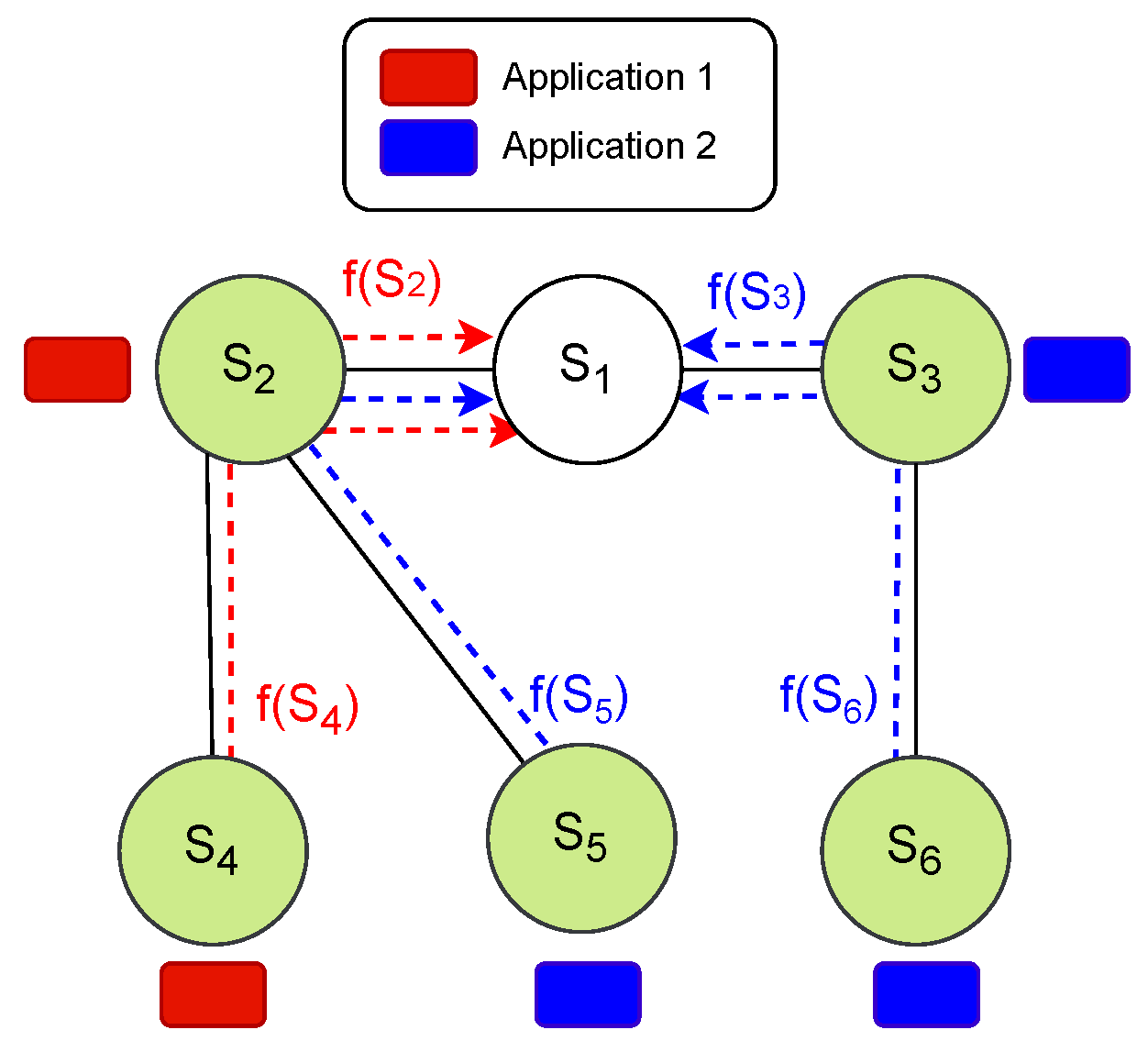
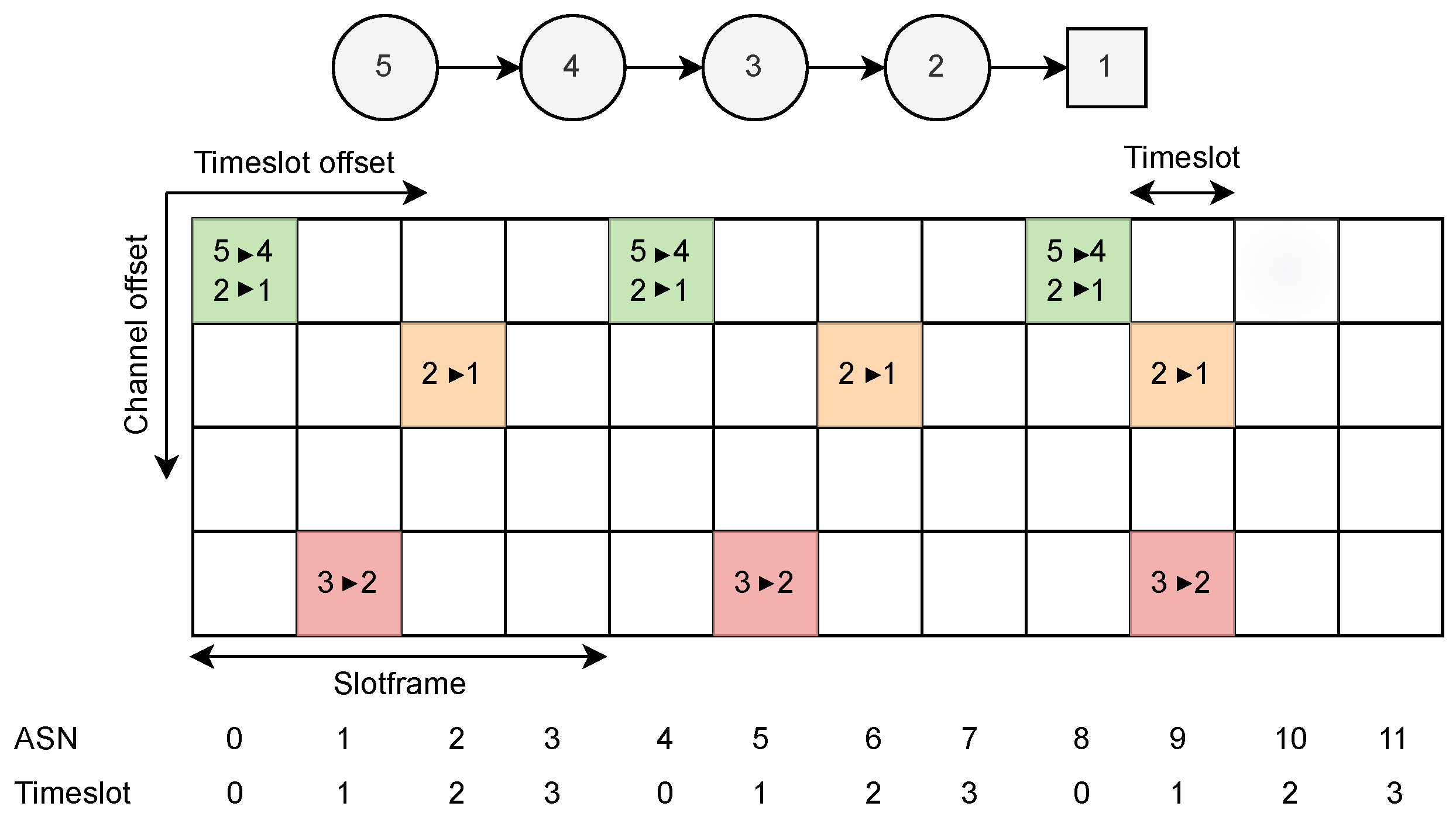



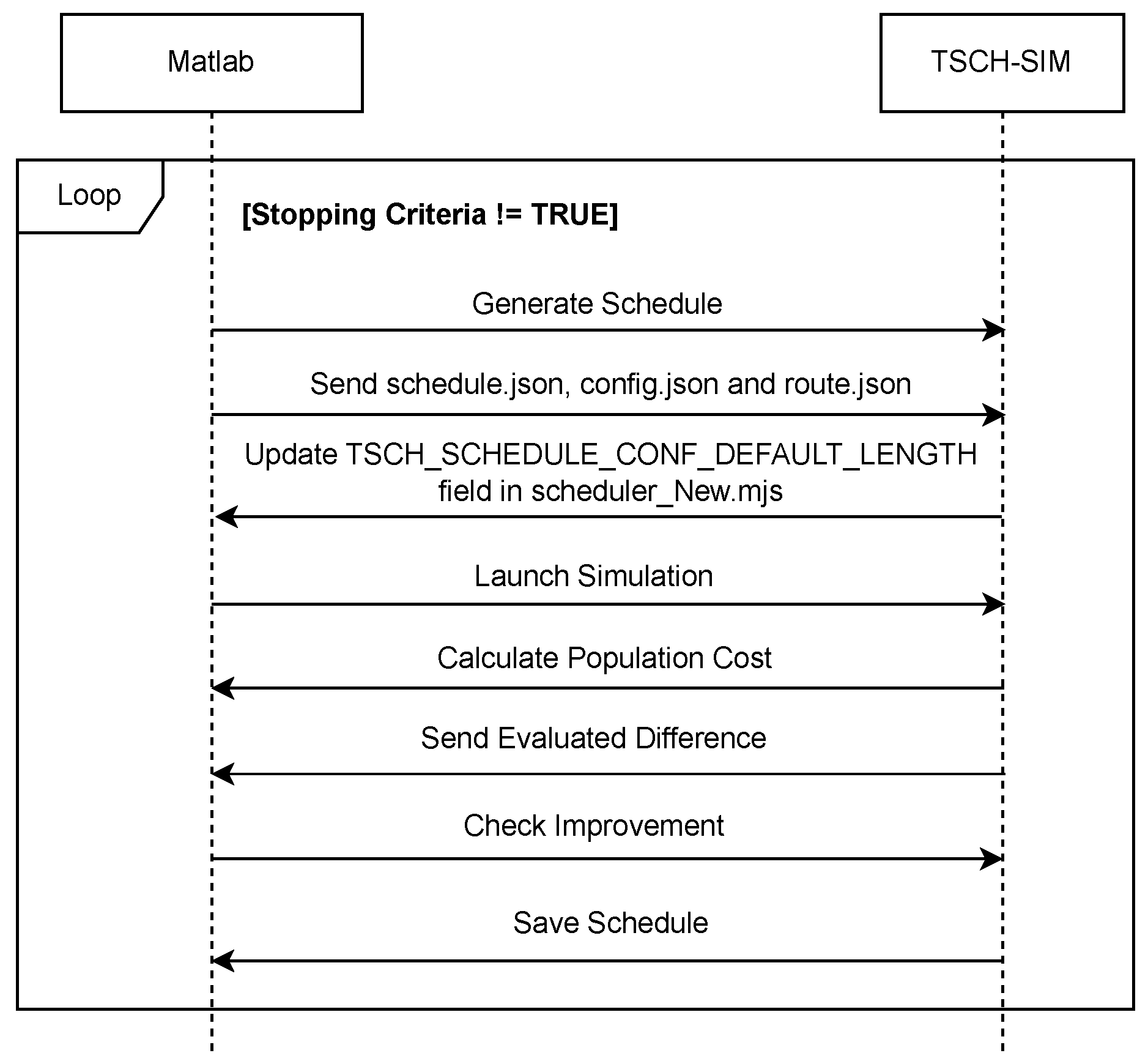
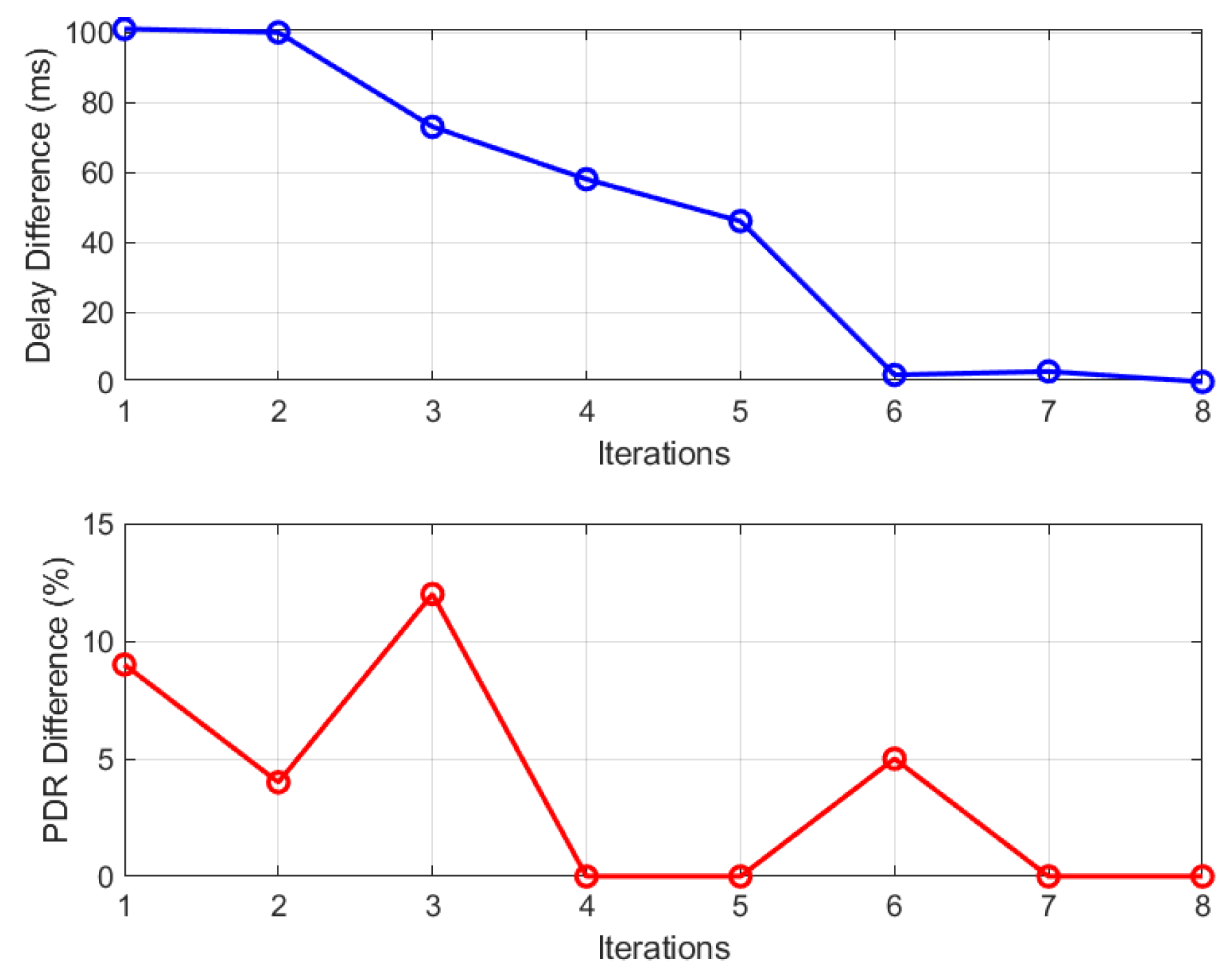
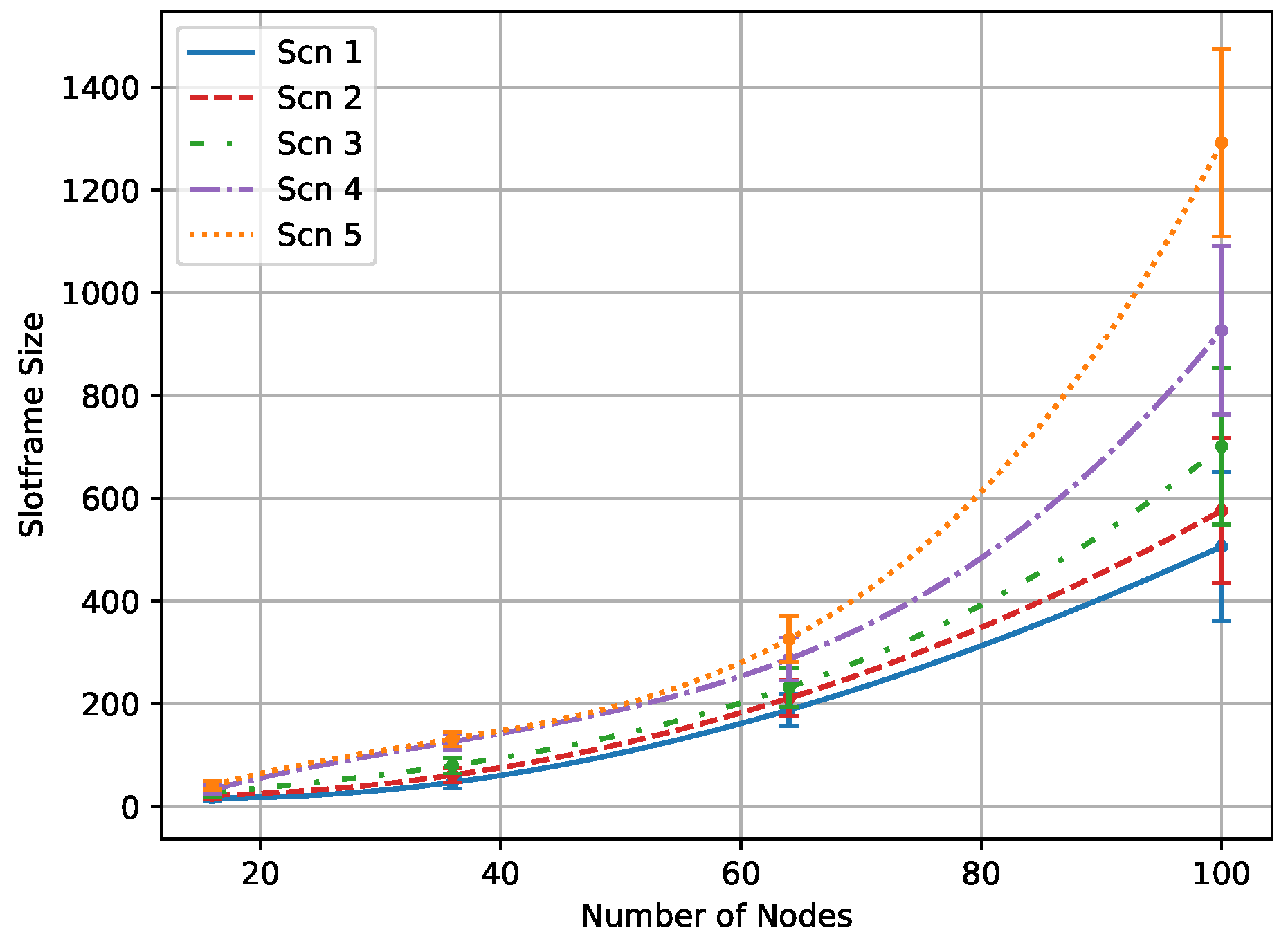
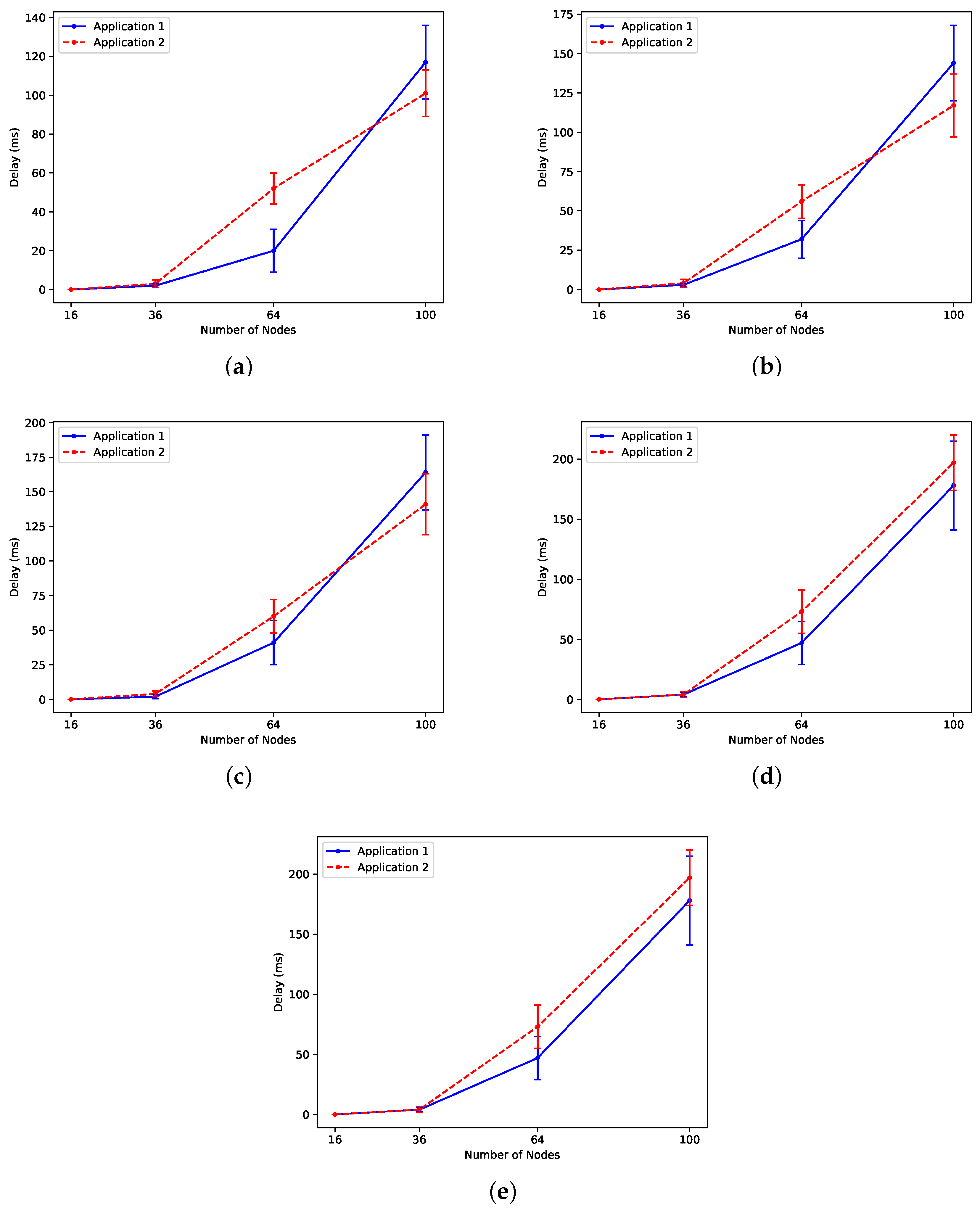




| Parameter | Description | Value |
|---|---|---|
| N | Total number of nodes | 16, 36, 64, 100 |
| Sensor with ID i | ||
| Packet rate | L (1 pkt/min), M (60 pkt/min) | |
| R | Communication range of node | 30 m |
| Distance between neighbors | 20 m | |
| m | Number of channel offsets | 4 |
| n | Maximum slotframe size | 500 |
| Maximum number of iteration | 50 | |
| Number of population | 5 | |
| Lower bound of decision variables | 1 | |
| Upper bound of decision variables | Variable | |
| Crossover probability | 0.7 | |
| Lower bound of scaling factor | 0.2 | |
| Upper bound of scaling factor | 0.8 | |
| Target delay for App 1 | 50 ms | |
| Target packet loss for App 1 | ||
| Target delay for App 2 | 100 ms | |
| Target packet loss for App 2 |
| Application | Class | Target Delay | Target Packet Loss | Packet Rate |
|---|---|---|---|---|
| App 1 | Class 2: closed-loop supervisory control | <50 ms | < | M |
| App 2 | Class 4: condition monitoring | <100 ms | < | L |
| Scenario | N | App 1 Proportion | App 2 Proportion |
|---|---|---|---|
| Scn 1 | 16, 36, 64, 100 | M (50%) | L (50%) |
| Scn 2 | 16, 36, 64, 100 | M (60%) | L (40%) |
| Scn 3 | 16, 36, 64, 100 | M (70%) | L (30%) |
| Scn 4 | 16, 36, 64, 100 | M (80%) | L (20%) |
| Scn 5 | 16, 36, 64, 100 | M (90%) | L (10%) |
| Parameter | Value |
|---|---|
| SIMULATION_DURATION | 3000 s |
| APP_WARMUP_PERIOD_SECOND | 1500 s |
| LINK_MODEL | Logistic Loss |
| APP_PACKET_SIZE | 100 |
| MAC_MAX_RETRIES | 7 |
| MAC_QUEUE_SIZE | 10 |
| LOGISTICLOSS_TRANSMIT_RANGE_M | 30 m |
| LOGLOSS_PATH_LOSS_EXPONENT | 3 |
| TSCH_SCHEDULE_DEFAULT_LENGTH | Derived slotframe size |
| ROUTING_ALGORITHM | ManualRouting [35] |
| SCHEDULING_ALGORITHM | ManualScheduler [35] |
Disclaimer/Publisher’s Note: The statements, opinions and data contained in all publications are solely those of the individual author(s) and contributor(s) and not of MDPI and/or the editor(s). MDPI and/or the editor(s) disclaim responsibility for any injury to people or property resulting from any ideas, methods, instructions or products referred to in the content. |
© 2024 by the authors. Licensee MDPI, Basel, Switzerland. This article is an open access article distributed under the terms and conditions of the Creative Commons Attribution (CC BY) license (https://creativecommons.org/licenses/by/4.0/).
Share and Cite
Vatankhah, A.; Liscano, R. Quality of Service-Aware Multi-Objective Enhanced Differential Evolution Optimization for Time Slotted Channel Hopping Scheduling in Heterogeneous Internet of Things Sensor Networks. Sensors 2024, 24, 5987. https://doi.org/10.3390/s24185987
Vatankhah A, Liscano R. Quality of Service-Aware Multi-Objective Enhanced Differential Evolution Optimization for Time Slotted Channel Hopping Scheduling in Heterogeneous Internet of Things Sensor Networks. Sensors. 2024; 24(18):5987. https://doi.org/10.3390/s24185987
Chicago/Turabian StyleVatankhah, Aida, and Ramiro Liscano. 2024. "Quality of Service-Aware Multi-Objective Enhanced Differential Evolution Optimization for Time Slotted Channel Hopping Scheduling in Heterogeneous Internet of Things Sensor Networks" Sensors 24, no. 18: 5987. https://doi.org/10.3390/s24185987
APA StyleVatankhah, A., & Liscano, R. (2024). Quality of Service-Aware Multi-Objective Enhanced Differential Evolution Optimization for Time Slotted Channel Hopping Scheduling in Heterogeneous Internet of Things Sensor Networks. Sensors, 24(18), 5987. https://doi.org/10.3390/s24185987






